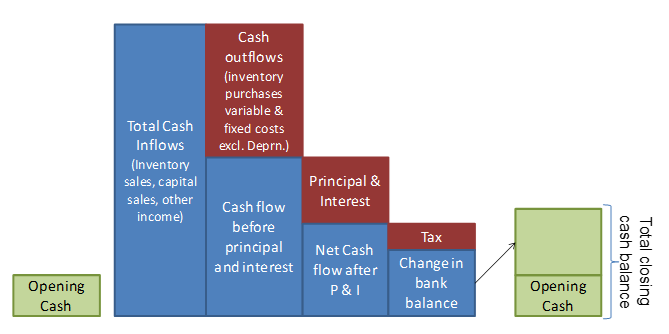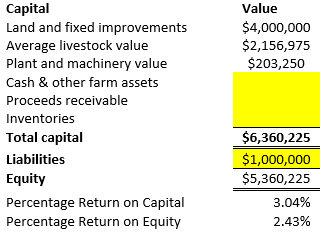Difference between revisions of "Net Profit"
| (9 intermediate revisions by the same user not shown) | |||
| Line 4: | Line 4: | ||
Net profit minus income tax minus personal consumption (above operators allowance if it has already been deducted from operating profit) = change in equity. Net Profit is available to the owner of the business to pay taxes or to provide living expenses (consumption) or can be used to reduce debt. (See figure 27) | Net profit minus income tax minus personal consumption (above operators allowance if it has already been deducted from operating profit) = change in equity. Net Profit is available to the owner of the business to pay taxes or to provide living expenses (consumption) or can be used to reduce debt. (See figure 27) | ||
| − | [[File: Figure 27.png|frame|Cash diagram]] | + | [[File: Figure 27.png|frame|center|Figure 27 Cash diagram]] |
| − | When net profit is expressed as a percentage return to the owners capital it indicates the efficiency of the use of the owners capital invested in the farm business. | + | ''When net profit is expressed as a percentage return to the owners capital it indicates the efficiency of the use of the owners capital invested in the farm business.'' |
Figure 30 shows a typical calculation for the percentage return on total capital, one of the main efficiency criteria for a beef business. It is calculated by dividing the operating profit by the total capital managed. The percentage return on equity is calculated by dividing the net profit by the owners’ equity and represents how well the owner’s capital preformed. | Figure 30 shows a typical calculation for the percentage return on total capital, one of the main efficiency criteria for a beef business. It is calculated by dividing the operating profit by the total capital managed. The percentage return on equity is calculated by dividing the net profit by the owners’ equity and represents how well the owner’s capital preformed. | ||
| − | [[File: Figure 30.PNG|frame|Capital invested and return on capital]] | + | [[File: Figure 30.PNG|frame|center|Figure 30 Capital invested and return on capital]] |
| + | |||
| + | '''How useful a measure is the percentage return on total capital or the percentage return on equity?''' | ||
| + | |||
| + | When a change is being considered it is probably better to look at the return to the extra capital being invested not the total capital invested. This is unless the change being considered is to shift all of the capital out of the current beef business. | ||
| + | |||
| + | The profit statement shown in Figure 30 is once again a snapshot that can be useful information but does not give us much guidance as to the best strategy to follow in the future. We will apply investment and cash flow budgets to do that task. The absolute and relative value of historical Operating and Net Profit may tell us something about the capacity of the business to fund change but tells us nothing about which change in management strategy may make the most improvement in the profit generated by the business. | ||
| + | |||
| + | The analyses done in the [[Investan]] program applies a partial discounted cash flow budgeting method, that looks at the difference between two strategies over time. | ||
Latest revision as of 06:58, 26 August 2020
Net Profit = Operating profit less the returns to outside capital (and other non-operating expenses).
As the returns to lenders of fixed capital (interest, rent and leases) are deducted from operating profit in the calculation of net profit, it therefore represents the return to the owner’s capital. Net profit minus income tax minus personal consumption (above operators allowance if it has already been deducted from operating profit) = change in equity. Net Profit is available to the owner of the business to pay taxes or to provide living expenses (consumption) or can be used to reduce debt. (See figure 27)
When net profit is expressed as a percentage return to the owners capital it indicates the efficiency of the use of the owners capital invested in the farm business.
Figure 30 shows a typical calculation for the percentage return on total capital, one of the main efficiency criteria for a beef business. It is calculated by dividing the operating profit by the total capital managed. The percentage return on equity is calculated by dividing the net profit by the owners’ equity and represents how well the owner’s capital preformed.
How useful a measure is the percentage return on total capital or the percentage return on equity?
When a change is being considered it is probably better to look at the return to the extra capital being invested not the total capital invested. This is unless the change being considered is to shift all of the capital out of the current beef business.
The profit statement shown in Figure 30 is once again a snapshot that can be useful information but does not give us much guidance as to the best strategy to follow in the future. We will apply investment and cash flow budgets to do that task. The absolute and relative value of historical Operating and Net Profit may tell us something about the capacity of the business to fund change but tells us nothing about which change in management strategy may make the most improvement in the profit generated by the business.
The analyses done in the Investan program applies a partial discounted cash flow budgeting method, that looks at the difference between two strategies over time.

